Back to Journals » Adolescent Health, Medicine and Therapeutics » Volume 14
Prevalence of Teenage Pregnancy and Associated Factors in Agago District, Uganda: A Community-Based Survey
Authors Okot C, Laker F, Apio PO, Madraa G, Kibone W , Pebalo Pebolo F, Bongomin F
Received 26 March 2023
Accepted for publication 29 July 2023
Published 7 August 2023 Volume 2023:14 Pages 115—124
DOI https://doi.org/10.2147/AHMT.S414275
Checked for plagiarism Yes
Review by Single anonymous peer review
Peer reviewer comments 2
Editor who approved publication: Professor Elie Al-Chaer
Christopher Okot,1 Florence Laker,1 Pamela Okwir Apio,2 Grace Madraa,3 Winnie Kibone,4 Francis Pebalo Pebolo,5 Felix Bongomin6
1Department of Public Health, Faculty of Medicine, Gulu University, Gulu, Uganda; 2Makerere Lung Institute, School of Medicine, Makerere University, Kampala, Uganda; 3Department of Rural Development and Agri-Business, Faculty of Agriculture, Gulu University, Gulu, Uganda; 4School of Medicine, College of Health Sciences, Makerere University, Kampala, Uganda; 5Department of Reproductive Health, Faculty of Medicine, Gulu University, Gulu, Uganda; 6Department of Medical Microbiology & Immunology, Faculty of Medicine, Gulu University, Gulu, Uganda
Correspondence: Felix Bongomin, Department of Medical Microbiology & Immunology, Faculty of Medicine, Gulu University, P.O. Box, 166 Gulu, Uganda, Email [email protected]
Background: Teenage pregnancy remains a common public health and social problem associated with negative health outcomes. We determined the prevalence and factors associated with teenage pregnancy among teenage girls aged 13– 17 years in Agago district, Uganda.
Methods: We conducted a community-based, cross-sectional study between October and November 2020 in Lapono Sub-County, Agago district among teenage girls 13– 17 years. Multi-stage sampling technique was used. Parishes, villages, and households were randomly selected (computer generated random numbers were used for household selection). In each household, one participant was randomly selected for interview and pregnancy testing. We collected data on socio-demographic factors using a pre-tested semi-structured questionnaire. All eligible participants were tested for urine human chorionic gonadotropin (hCG). Multivariable logistic regression analysis was done to determine independent predictors of teenage pregnancy, with p< 0.05 considered statistically significant.
Results: A total of 289 eligible participants, with a mean age of 15.1± 1.5 years, were enrolled. Most (n=246, 81.5%) participants had attained primary education, 18 (6.2%) were married, 41 (14.2%) used alcohol, 62 (21.5%) had a history of sexual intercourse and 32 (11.1%) were sexually abused. The prevalence of teenage pregnancy was 2.8% (n=8). Factors significantly associated with teenage pregnancy were alcohol consumption (adjusted odds ratio (aOR): 13.2, 95% Confidence Interval (95% CI): 1.7– 100.6, p=0.013) and having secondary/tertiary education (aOR: 10.2, 95% CI: 1.5– 71.9, p=0.02).
Conclusion: The study findings suggest that teenage pregnancy is still a public health and social problem in Agago district, Uganda. Interventions discouraging alcohol consumption and promoting education among teenagers are key in addressing the burden of teenage pregnancies in the district.
Keywords: teenage pregnancy, human chorionic gonadotropin, Agago, Uganda
Introduction
Teenage pregnancy, defined as “pregnancy in a teenage girl, usually within the ages of 10–19 years, without having reached legal adulthood,1 has been recognized as a public health concern that contributes a significant economic, health, and social cost to the mothers and newborn babies, their families, and the wider society.2 The global pregnancy rate in 2021 was 42.5 births per 1000 women, with Latin America and Sub-Saharan African (SSA) regions having the highest rates of 53.2 and 101 births per 1000 women, respectively.3 According to the World Health Organisation (WHO), about 21 million teenage pregnancies occurred each year by 2019 with 55% of the unintended teenage pregnancies occurring in low- and middle-income countries.4 Teenage pregnancy rate is highest in SSA followed by South Asia,5 and the relatively high fertility desires in SSA were rooted in traditional pronatalist practices that partly explained the lowest prevalence of contraception in the region.6
Several factors such as limited education increased accessibility to social media and pornographic sharing, cross-cultural influences and decreased supervision by adults,7 early marriage, early initiation of sex, and lack of access to reproductive health information and services8 perpetuate teenage pregnancies, particularly in developing countries. Teenage is associated with serious obstetric complications (eclampsia, fistula, puerperal infections, and death), mainly due to immaturity and lack of readiness of the reproductive organs to accommodate the physiological changes of pregnancy;3 contributes significantly to maternal and child mortality, intergenerational cycles of ill-health and poverty;9 poor maternal growth, undernutrition and morbidity during childbirth;10 increased risk of antenatal complications, failure to complete schooling, welfare dependence and societal stigma and discrimination, maternal difficulties depression and incompetent parenting.2 Children born to very young teenage mothers are at an increased risk of morbidity and death;11 health problems (preterm birth, low birth weight, intrauterine growth retardation, neonatal death), physical injury, behavioral difficulties, cognitive problems, and educational underachievement compared to those born to the adult mothers.2
In Uganda, the burden of teenage pregnancy varies across regions ranging from 16% in Kigezi to 31% in Teso region.11 In Northern Uganda, a prevalence of about 25% has been estimated.7 Addressing teenage pregnancy in Uganda is key in meeting the United Nation’s (UN) Sustainable Development Agenda 2030 targets on ensuring healthy lives and wellbeing at all ages and National Development Plan III, Health Sector Strategic Plans I and II and Vision 2040 for Sustainable Development. Therefore, this study aimed to evaluate the prevalence and factors associated with teenage pregnancy in Agago district, Uganda.
Methods
Study Design and Settings
We conducted a community-based, descriptive, cross-sectional study between October and November 2020 among teenage girls in Lapono Sub-County, Agago district.
Study Population
We recruited teenage girls aged 13–17 years who were residing within Lapono Sub-County for at least one year and provided a written informed assent. Teenage girls aged 13–17 years were considered because they might be aware of their bodies and below the adult age of 18 years as per the Constitution of Uganda. Teenage girls who were severely sick and those with mental impairment were excluded from the study.
Study Procedures
A multi-stage sampling technique was employed in this study. Three parishes and four villages from each parish were randomly selected from Lapono Sub-County, Agago district. Kish Leslie’s (1965) formula was utilized to obtain the optimal number of participants. A total of 289 households with teenage girls 13–17 years were randomly enrolled in this study given a standard error of the confidence level (1.96) at 95% confidence interval, the proportion of teenage pregnancy among teenage girls, estimated at 24% for Acholi Sub-region11 and margin of error assumed at 5%. Lists of all the households in the selected villages were generated with the support of the Local Council one. Using a computer-generated random numbers in the range of 1–300, the required numbers of households in each village were randomly chosen. In each household, one teenage girl was randomly selected for the interview and testing for pregnancy. The household selection was based on probability proportional to size. Data on socio-demographic, individual, familiar and socio-cultural characteristics of the teenage girls and their parents were collected using a pre-tested semi-structured questionnaire consisting of 28 questions (17 for individual, 5 for familial, and 6 for socio-cultural variables) that provide answers on the prevalence of teenage pregnancy and the individual, familiar socio-cultural factors associated with teenage pregnancy.
Assessment of Teenage Pregnancy
Pregnancy was tested using the human chorionic gonadotropin (hCG) hormone assay on urine samples. About 10–15 mls of fresh mid-stream urine samples into sterile universal containers by teenage girls under the supervision of female research assistants (Laboratory Technician or Clinical Officer). Within 1–2 minutes after urine sample collection, the urine containers were placed on a flat surface, hCG strips were inserted vertically for 10–15 seconds into them and removed. Pregnancy test results were read after 15 minutes, positive pregnancy test results were shown by two distinct red lines in control (C) and test (T) regions, and negative pregnancy test results by one red line in the control (C) region only.
Data Analysis
All analyses were done in STATA version 17.0 at 95% confidence and 5% margin of error for univariate, bivariate and multivariate levels. We estimated the prevalence of teenage pregnancy among teenage girls in percentage and reported confidence intervals. The factors associated with teenage pregnancy among teenage girls in Lapono Sub-County, Agago district, Uganda were assessed using logistic regression analysis. In univariate analysis, we summarized continuous variable (age) using mean with its corresponding standard deviation. Categorical variables were summarized by means of frequencies and percentages. In bivariate analysis, the associations of independent variables against teenage pregnancy were assessed and variables with p <0.2 were considered in multivariate analysis. In multivariate analysis, variables were manually removed, starting with the least significant variable. Product terms were formed between variables with p < 0.05 and assessed for interaction using a chunk test. Assessment of confounding was done by bringing back the basic variables that were dropped in the model, starting with the variables that were dropped last and checking for percentage change. A percentage change of >10% meant there was confounding. All confounders were retained in the final model. Goodness-of-fit test was done using Hosmer-Lemeshow test. Variables with p <0.05 after multivariate analysis were statistically significant.
Ethical Considerations
Gulu University Research Ethics Committee (GUREC) approved the study protocol, approval number GUREC-073-20 followed by administrative clearance from Agago District Health Officer, Lapono Sub-County Chief Local Council One of the selected villages. Before participation in the study, teenage girls and their parents/caretakers were fully informed on the research purpose, probable benefits, possible risks, pregnancy test procedures and referral arrangements for those who could test positive for pregnancy. Both the teenage girl and her parent/caretaker provided a written an informed assent and consent and participation was on a voluntary basis. Only codes were used to identify study participants. Teenage girls were counselled before collecting urine samples in privacy. Pregnancy test results were released in privacy and all information received was maintained confidentially throughout the study. The study complied with the Declaration of Helsinki involving human subjects.
Results
Sociodemographic Characteristics
A total of 289 participants were enrolled mean age of 15.1±1.5 years. Most of the teenage girls lived in rural areas 155 (53.6%), attained primary education 246 (81.5%) and had both parents alive 240 (83.0%). Only 18 (6.2%) girls were married and a third 88 (30.5%) were living with either only one parent or a relative. Forty-one (14.2%) participants reported alcohol use. Christianity was the dominant religion 265 (91.7%) and majority of their parents had a low socio-economic 273 (94.5%) background, Table 1.
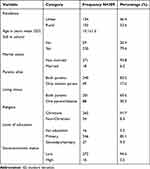 |
Table 1 Baseline Socio-Demographic Characteristics of 289 Participants in Lapono Sub-County |
Sexual History
Sixty-two (21.5%) participants had a lifetime history of sexual intercourse. Participants who experienced sexual and physical abuse were 32 (11.1%) and 116 (40.1%), respectively. Sixty-eight (23.5%) participants had sexual education and 148 (51.2%). Close to a third 84 (29.1%) of the participants reported having felt pressure to engage in sexual intercourse. Most teenage girls disagreed that it was not acceptable to have sex 264 (91.4%) and get married 262 (90.7%) before the age of 18 years, Table 2.
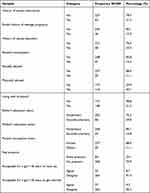 |
Table 2 Family, individual and socio-cultural factors of teenage girls in Lapono Sub-County |
Prevalence of Teenage Pregnancy
The prevalence of teenage pregnancy was 2.8% (95% CI 1.385, 5.458). Out of the 62 teenage girls with a history of sexual engagement, 35 (56.5%) had their first sexual intercourse when they were less than 16 years, and 20 (32.3%) had more than one sexual partner. Overall, 20 (6.9%) used contraceptives, 17 (85%) always used contraceptives when having sexual intercourse, Table 3
 |
Table 3 Characteristics of Teenage Girls with a History of Sexual Engagement in Lapono Sub-County |
Factors Associated with Teenage Pregnancy Among Study Participants
At bivariate analysis, age (OR 3.032, 95% CI 1.208, 7.613, p=0.018), still in school (OR 0.243, 95% CI 0.059, 1.003, p=0.051), marital status (OR 10.640, 95% CI 2.320, 48.791, p=0.002) and Level of education (OR 10.729, 95% CI 2.561, 44.932, p=0.001) were all associated with teenage pregnancy and considered for multivariate analysis, including residence (OR 6.291, 95% CI 0.764, 51.800, p=0.087), Table 4.
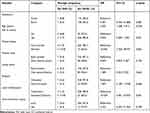 |
Table 4 Bivariate analysis of socio-demographic factors with teenage pregnancy (N=289), Lapono Sub-County |
Alcohol consumption (OR 11.343, 95% CI 2.599, 49.504, p<0.001), and sexual abuse (OR 5.214, 95% CI 1.184, 22.951, p=0.029) showed a positive association with teenage pregnancy and were considered for multivariate analysis, Table 5.
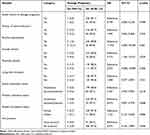 |
Table 5 Bivariate Analysis of Family, Individual and Sociocultural Factors of 289 Teenage Girls in Lapono Sub-County |
At multivariable analysis, alcohol consumption (AOR 13.22, C 1.74, 100.63, p=0.013) and having secondary/tertiary education (AOR 10.20, 95% CI 1.45, 71.89, p=0.020) were associated with higher odds of teenage pregnancy. Residence (AOR 7.45, 95% CI 0.71, 78.18, p=0.094) was a confounder in the relationship between level of education and teenage pregnancy. Age (AOR 2.00, 95% CI 0.74, 5.45, p=0.174) was a confounder in the relationship between predictors (alcohol consumption and level of education) and teenage pregnancy. Marital status (AOR 3.59, 95% CI 0.36, 36.01, p=0.277) was a confounder in the relationship between alcohol consumption and teenage pregnancy. Sexually abused (AOR 0.45, 95% CI 0.05, 3.92, p=0.469) was a confounder in the relationship between predictors (alcohol consumption and level of education) and teenage pregnancy. Still in school (AOR 0.88, 95% CI: 0.09, 8.54, p=0.915) was a confounder in the relationship between the level of education and teenage pregnancy, Table 6.
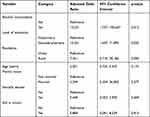 |
Table 6 Multivariate Analysis of Factors Associated with Teenage Pregnancy Among 289 Girls in Lapono Sub-County |
Discussion
In this study, we sought to determine the prevalence and factors associated with teenage pregnancy in Agago district, Uganda. We found the prevalence to be low estimated at 2.8%. This result is far below the 25% national prevalence of teenage pregnancy reported in the 2016 Uganda Demographic and Health Survey,11 and the prevalence of 28.6% reported in Northern Ethiopia.12 The difference in the prevalence of teenage pregnancy could have been due to differences in the measurement of outcome. In this study, teenage pregnancy was determined by rapid hCG test for urine while in the study by Habitu and colleagues, pregnancy status was based on self-report which is unreliable and may over or underestimate the true burden of teenage pregnancies. Agago district about 5 years had the highest prevalence of teenage pregnancy in the country, which raised alarm among different stakeholders (community members, health implementing partners, local leaders, politicians, district officials), attracting concerted efforts, supporting awareness campaigns on the dangers of teenage pregnancy among the teenage girls could have played a role in reducing the prevalence of teenage pregnancy.
The low prevalence of teenage pregnancy could be due toto a missed opportunity to capture deliveries among teenage girls during the time of the study; parents/caretakers of teenage girls might have had the opportunity during COVID-19 lockdowns to closely watch and monitor their teenage girls well, stopping them from engaging in risky sexual practices since the study was conducted during the time of COVID-19 pandemic when people were confined at homes. As found, most of the teenage girls had both of their parents alive (83.0%), which could have offered chances for them to get good sexual advice and guidance related to sexual education, especially from their mothers, empowering them to make an informed sexual decision, thus protecting them from the risk of teenage pregnancy.7 However, the protective effect of having both parents alive was not significant when included in the multivariable logistic regression model.
The factors associated with teenage pregnancy were level of education, marital status, still in school status and age greater or equal to 15 years. Much as education was found to offer a protective effect against teenage pregnancy, which is consistent with the studies by Poudel and colleagues in Nepal,5 Mathewos & Mekuria in Southern Ethiopia13 and Ochen and colleagues in Uganda, where in particular they noted that teenage girls in school might have opportunity for supervision by teachers and parents.7 However, in multivariate analysis, teenage girls in secondary/tertiary schools had about 10.2-folds higher odds of becoming pregnant than those in primary schools. This may be an indication of negative peer influences by their colleagues in secondary/tertiary schools to get into sexual relationships with their fellows (get boyfriends) and smart phone usage exposuring them to surf explicit content motivating early sex, increasing opportunities for sexual activity.14
Married teenagers had just over 10-folds higher odds of teenage pregnancy than unmarried. This finding is in keeping with a study in Ethiopia which showed that early marriage exposes a teenage girl to frequent and unprotected sexual activity, often leading to an early and risky first birth.15 An earlier study in Uganda revealed that keeping teenage girls in school significantly declined child marriage among women 15–19 years and early sexual debut between 2006 and 2016.16 Apart from early teenage birth, early marriage may result in poor health outcomes and intergenerational cycle of poverty, as it restricts future opportunities for development, studying and employment. However, it contradicts the result found in Hoima district in Uganda that shows unmarried teenage girls were 9 folds more likely to get pregnant during the COVID-19 pandemic compared to their married counterparts.17 The different situations created due to the COVID-19 pandemic could have contributed to this finding.
Teenage girls 15 years and above were at high risk of teenage pregnancy. This finding is similar to other studies by Bukenya et al, in rural settings in Eastern Uganda, which indicated up to 38.0% of teenage girls 15–19 years old reported having been involved in sexual intercourse18 and slightly below the study in Fartaworeda, Northwest, Ethiopia, that show teenage girls 13–14 years were more likely to become pregnant compared to those aged 18–19 years.19 Teenage girls at this age undergo a growth stage (puberty) in which their bodies experience hormonal changes that make them sexually active. With a huge urge to initiate and experiment adult sexual intercourse at this age, there is a high risk for unintended pregnancy and sexually transmitted infections, and negative social outcomes, such as school dropout and social exclusion for teenage girls.1 A key requirement for getting pregnant is by having unprotected sexual intercourse and once teenage girls get involved in sexual intercourse, the possibility of them becoming pregnant increases. With an increased demand for sex, teenage girls are eager to engage in risky sexual practices that make them vulnerable to teenage pregnancy.
Individual factors such as alcohol consumption influenced teenage pregnancy. Teenage girls involved in alcohol use had 13-folds higher odds of experiencing teenage pregnancy than those who did not. This result agrees well with the studies by13 in Southern Ethiopia and Yakubu and Salisu in Nepal,14 where they found excessive consumption of alcohol and substance abuse increase vulnerability and make teenage girls become targets for sexual exploits. Involvement in alcohol consumption by teenage girls can distort their sexual decision-making ability to resist unprotected sexual intercourse; reduce the opportunity to practice safer sex; compromise their normal sense of judgment of the situation, and increase sexual libido and vulnerability for sexual exploits by strangers. This puts them at greater risk of getting pregnant and contracting sexually transmitted infections.
Limitations and Strengths of the Study
This study has some limitations. There were few positive pregnancy cases (08) identified in the study that could not permit a robust manipulation of the data and resulted in a wider confidence interval which could affect the generalizability of the study findings. However, the strength of our study is in its community-based design, which is likely to reflect the population prevalence of teenage pregnancy. We also used urine-based hCG studies and therefore we got the true reflection of teenage pregnancy.
Conclusions
Overall, we found a prevalence of teenage pregnancy of about 3%, with individuals involved in alcohol consumption and older teenagers in secondary/tertiary education being more likely to get pregnant. These findings inform setting up of interventions targeting alcohol consumption reduction and promoting education may help reduce the prevalence of teenage pregnancy among teenage girls in the district.
Data Sharing Statement
All data generated or analyzed during this study are included in this published article.
Acknowledgment
Many thanks to SURVIVAL-PLUSS Project for providing me with financial assistance towards the completion of this research report. Finally, I would like to thank those whose names did not appear here but have contributed in one way or the other to this research work.
Funding
Many thanks to SURVIVAL-PLUSS Project for providing me with financial assistance towards the completion of this research report.
Disclosure
The authors declare that they have no competing interests in this work.
References
1. World Health Organization. Guidance on ethical considerations in planning and reviewing research studies on sexual and reproductive health in adolescents; 2018:52. Available from: https://apps.who.int/iris/handle/10665/273792. Accessed August 3, 2023.
2. Okoli CI, Hajizadeh M, Rahman MM, Velayutham E, Khanam R. Socioeconomic inequalities in teenage pregnancy in Nigeria: evidence from Demographic Health Survey. BMC Public Health. 2022;22(1):1–11. doi:10.1186/s12889-022-14146-0
3. Chuwa AH. Sexuality education is key to addressing adolescent pregnancies in Tanzania; a cross-sectional study and content analysis of vital national reports. Preprint. 2023 ;1–9. doi:10.21203/rs.3.rs-2497299/v1
4. UNICEF. Towards Ending Child Marriage - UNICEF DATA. UNICEF; 2021.
5. Poudel S, Upadhaya N, Khatri RB, Ghimire R. Trends and factors associated with pregnancies among adolescent women in Nepal: pooled analysis of Nepal Demographic and Health Surveys. PLoS One. 2018;13:e0202107.
6. Ariho P. Age at first marriage, age at first sex, family size preferences, contraception and change in fertility among women in Uganda: analysis of the 2006 – 2016 period. BMC Women's Health. 2020;4:1–13.
7. Ochen AM, Chi PC, Lawoko S. Predictors of teenage pregnancy among girls aged 13-19 years in Uganda: a community based case-control study. BMC Pregnancy Childbirth. 2019;19(1):1–14. doi:10.1186/s12884-019-2347-y
8. Kasozi GK, Kasozi J, Kiyingi FP, Musoke M. School-based sexual and reproductive health services for prevention of adolescent pregnancy in the hoima district, Uganda: cluster randomized controlled trial. Methods Protocol. 2019;2:1–15.
9. Kiani MA, Ghazanfarpour M, Saeidi M. Adolescent Pregnancy. A Health Challenge. 2019;7(67):9749–9752.
10. Marphatia AA, Saville NM, Amable GS, Manandhar DS. How Much Education Is Needed to Delay Women’s Age at Marriage and First Pregnancy ? Front Public Heal. 2020;7:356.
11. UBOS. Uganda 2016 Demographic and Health Survey: Key Findings. Uganda 2016 Demogr Heal Surv; 2016.
12. Habitu YA, Yalew A, Bisetegn TA. Prevalence and Factors Associated with Teenage Pregnancy, Northeast Ethiopia, 2017: a Cross-Sectional Study. Hindawi J Pregnancy. 2018;2018:89.
13. Mathewos S, Mekuria A. Teenage Pregnancy and Its Associated Factors among School Adolescents of Arba Minch Town, Southern Ethiopia. Ethiop J Health Sci. 2018;28(3):287–298. doi:10.4314/ejhs.v28i3.6
14. Yakubu I, Salisu WJ. Determinants of adolescent pregnancy in sub-Saharan Africa: a systematic review. Reprod Health. 2018;15(1). doi:10.1186/s12978-018-0460-4
15. Mezmur H, Assefa N, Alemayehu T. Teenage pregnancy and its associated factors in eastern Ethiopia: a community-based study. Int J Women's Health. 2021;13:267–278.
16. Mbabazi C, Kintu A, Asiimwe JB, Ssekamatte JS, Shah I, Canning D. Proximate and distal factors associated with the stall in the decline of adolescent pregnancy in Uganda. BMC Public Health. 2021;21(1):1–13. doi:10.1186/s12889-021-11403-6
17. Musinguzi M, Kumakech E, Auma AG, et al. Prevalence and correlates of teenage pregnancy among in-school teenagers during the COVID-19 pandemic in Hoima district western Uganda-A cross sectional community-based study. PLoS One. 2022;17(12 December):1–16. doi:10.1371/journal.pone.0278772
18. Bukenya JN, Nakafeero M, Ssekamatte T, Isabirye N, Guwatudde D, Fawzi WW. Sexual behaviours among adolescents in a rural setting in eastern Uganda: a cross-sectional study. Trop Med Int Heal. 2020;25(1):81–88.
19. Kassa BG, Belay ADA HG. Teenage pregnancy and its associated factors among teenage females in Farta woreda, Northwest, Ethiopia, 2020: a community-based cross-sectional study. Popul Med. 2021;3:1–8. doi:10.18332/popmed/139190
 © 2023 The Author(s). This work is published and licensed by Dove Medical Press Limited. The full terms of this license are available at https://www.dovepress.com/terms.php and incorporate the Creative Commons Attribution - Non Commercial (unported, v3.0) License.
By accessing the work you hereby accept the Terms. Non-commercial uses of the work are permitted without any further permission from Dove Medical Press Limited, provided the work is properly attributed. For permission for commercial use of this work, please see paragraphs 4.2 and 5 of our Terms.
© 2023 The Author(s). This work is published and licensed by Dove Medical Press Limited. The full terms of this license are available at https://www.dovepress.com/terms.php and incorporate the Creative Commons Attribution - Non Commercial (unported, v3.0) License.
By accessing the work you hereby accept the Terms. Non-commercial uses of the work are permitted without any further permission from Dove Medical Press Limited, provided the work is properly attributed. For permission for commercial use of this work, please see paragraphs 4.2 and 5 of our Terms.
